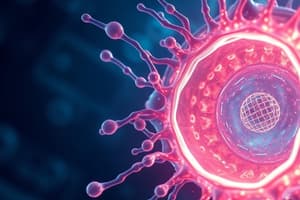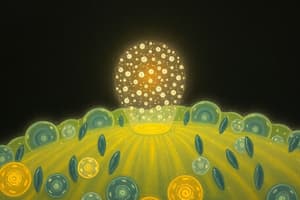Podcast
Questions and Answers
What is the primary function of the phospholipid bilayer in the cell membrane?
What is the primary function of the phospholipid bilayer in the cell membrane?
- To regulate what enters and leaves the cell (correct)
- To synthesize proteins
- To store genetic information
- To provide mechanical support and protection
Which type of cell division results in four non-identical daughter cells?
Which type of cell division results in four non-identical daughter cells?
- Endosymbiosis
- Meiosis (correct)
- Binary Fission
- Mitosis
What is the term for the movement of water molecules through a selectively permeable membrane?
What is the term for the movement of water molecules through a selectively permeable membrane?
- Facilitated Diffusion
- Osmosis (correct)
- Diffusion
- Active Transport
What is the term for the movement of molecules from high to low concentration?
What is the term for the movement of molecules from high to low concentration?
Which organelle is responsible for synthesizing proteins?
Which organelle is responsible for synthesizing proteins?
Which stage of cell division is characterized by the alignment of chromosomes at the cell center?
Which stage of cell division is characterized by the alignment of chromosomes at the cell center?
What is the term for the movement of molecules against their concentration gradient, requiring energy?
What is the term for the movement of molecules against their concentration gradient, requiring energy?
Which type of cell lacks a true nucleus and membrane-bound organelles?
Which type of cell lacks a true nucleus and membrane-bound organelles?
What is the function of the Golgi apparatus in a cell?
What is the function of the Golgi apparatus in a cell?
Which process occurs during interphase, prior to cell division?
Which process occurs during interphase, prior to cell division?
Flashcards are hidden until you start studying
Study Notes
Cell Structure
- Eukaryotic cells: have a true nucleus and membrane-bound organelles
- Prokaryotic cells: lack a true nucleus and membrane-bound organelles
- Cell shape and size vary depending on function and environment
Cell Membrane
- Semi-permeable membrane that separates cell from environment
- Composed of phospholipid bilayer with embedded proteins
- Functions:
- Regulates what enters and leaves the cell
- Maintains cell shape and structure
- Provides mechanical support and protection
Cell Transport
- Passive Transport:
- Diffusion: movement of molecules from high to low concentration
- Osmosis: movement of water molecules through a selectively permeable membrane
- Facilitated Diffusion: assisted diffusion through transport proteins
- Active Transport:
- Requires energy (ATP) to move molecules against concentration gradient
- Examples: pumping ions, transporting molecules into/out of cell
Cell Division
- Types:
- Mitosis: division of somatic cells (body cells) resulting in 2 identical daughter cells
- Meiosis: division of sex cells (gametes) resulting in 4 non-identical daughter cells
- Stages of Cell Division:
- Interphase: cell growth and preparation for division
- Prophase: condensation of chromosomes and breakdown of nuclear envelope
- Metaphase: alignment of chromosomes at cell center
- Anaphase: separation of sister chromatids
- Telophase: reconstruction of nuclear envelope and chromosomes uncoil
- Cytokinesis: division of cytoplasm and separation of daughter cells
Cellular Organelles
- Nucleus: contains genetic material (DNA) and regulates gene expression
- Mitochondria: generates energy for the cell through cellular respiration
- Endoplasmic Reticulum (ER):
- Rough ER: involved in protein synthesis and transport
- Smooth ER: involved in lipid synthesis and detoxification
- Ribosomes: site of protein synthesis
- Lysosomes: contains digestive enzymes for breaking down cellular waste and foreign substances
- Golgi Apparatus: involved in protein modification, sorting, and packaging for transport
- Cytoskeleton: provides structural support, shape, and movement to the cell
Cell Structure
- Eukaryotic cells have a true nucleus, which contains genetic material, and membrane-bound organelles that perform specific functions.
- Prokaryotic cells lack a true nucleus and membrane-bound organelles, making them smaller and simpler in structure.
- Cell shape and size vary depending on the function they perform and the environment they inhabit.
Cell Membrane
- The cell membrane is a semi-permeable membrane that separates the cell from its environment.
- It is composed of a phospholipid bilayer with embedded proteins that help regulate the movement of molecules.
- The cell membrane has three main functions: regulating what enters and leaves the cell, maintaining cell shape and structure, and providing mechanical support and protection.
Cell Transport
- Passive transport is the movement of molecules from an area of high concentration to an area of low concentration without the use of energy.
- Diffusion is the movement of molecules from high to low concentration until equilibrium is reached.
- Osmosis is the movement of water molecules through a selectively permeable membrane from an area of high concentration to an area of low concentration.
- Facilitated diffusion is the assisted diffusion of molecules through transport proteins, which helps to speed up the process.
- Active transport is the movement of molecules against their concentration gradient using energy from ATP.
- Active transport is used to pump ions, transport molecules into or out of the cell, and maintain proper ion balance.
Cell Division
- Mitosis is the division of somatic cells (body cells) resulting in two identical daughter cells.
- Meiosis is the division of sex cells (gametes) resulting in four non-identical daughter cells.
- Interphase is the stage of cell division where the cell grows and prepares for division.
- Prophase is the stage of cell division where the chromosomes condense and the nuclear envelope breaks down.
- Metaphase is the stage of cell division where the chromosomes align at the cell center.
- Anaphase is the stage of cell division where the sister chromatids separate.
- Telophase is the stage of cell division where the nuclear envelope reforms and the chromosomes uncoil.
- Cytokinesis is the stage of cell division where the cytoplasm divides and the daughter cells separate.
Cellular Organelles
- The nucleus is the organelle that contains genetic material (DNA) and regulates gene expression.
- Mitochondria are the organelles responsible for generating energy for the cell through cellular respiration.
- Rough ER is involved in protein synthesis and transport, while smooth ER is involved in lipid synthesis and detoxification.
- Ribosomes are the site of protein synthesis.
- Lysosomes contain digestive enzymes for breaking down cellular waste and foreign substances.
- The Golgi apparatus is involved in protein modification, sorting, and packaging for transport.
- The cytoskeleton provides structural support, shape, and movement to the cell.
Studying That Suits You
Use AI to generate personalized quizzes and flashcards to suit your learning preferences.




